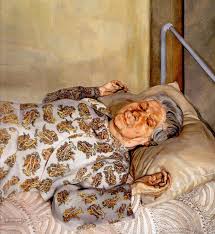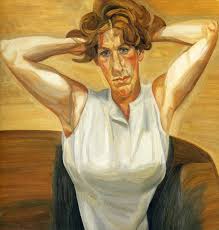What
is known as the ‘creative’ process is a mysterious act that
engages theorists and analysts, academics who specialise in rational
thought and review outside of the artists’ world. It is as if they
might know. Yet the attempt to establish some sense and understanding
of the process is still made. One wonders why, because it has
frequently been pointed out that the process is not a matter of
applying any rules or patterns of thought to a situation, no matter
how inventive these might appear. The artists’ act is more than reasoned invention.*
Occasionally
artists write about their experiences and try to offer insights into
their different world. Their efforts to explain their emotional
journey, their ‘creative’ enterprise, seek to elucidate events
for others to comprehend. Only once in his life did Lucian Freud
write about his experience of painting. Towards the end of Freud’s
life, Geordie Greig tried to get him to once more write about his
art. Freud was reluctant, and, after some thought and time, simply
confirmed his previous text and added a few cryptic notes to it.
Greig published these comments along with the original writing in the
Tatler.
Geordie Greig
The following are a few notes on the subject recorded from Breakfast with Lucian A Portrait of the Artist by
Geordie Greig. It is interesting to read the words in association with some of Freud's paintings.
Lucian
Freud, in spite of his unique lifestyle, liked his privacy. He hated
to be watched. He disliked blatant promotion, but did enjoy its
outcomes in spite of this position. He wrote about his act of
painting only once, in Encounter, [‘Some Thoughts on Painting’], a publication edited by
Stephen Spender.
Freud's mother
Lucian
had not seen a copy of Encounter
for decades and enjoyed seeing reproductions of his pictures . . .
As we sat in Clarke's (the breakfast venue) I read aloud
part of his 1954
essay . . . 'My object in painting pictures is to try and move the
senses by giving an intensification of reality. Whether this can be
achieved depends on how intensely the painter understands and feels
for the person or object of his choice.'
Francis Bacon
His
views had barely altered . . . The original words, Lucian said, had
been hard-wrought, chosen with the same perfectionist zeal with which
he applied paint, almost chiselled from his mind. He had expressed
disdain for abstract art, arguing vigorously the case for the
superiority of figurative art: 'Painters who deny themselves the
representation of life and limit their language to purely abstract
forms are depriving themselves of the possibility of provoking more
then an aesthetic emotion.'
Freud's mother
He
believed the human body was the most profound subject and he pursued
a ruthlessness of observation, using the forensic exactitude of a
scientist dissecting an animal in a laboratory. . . .
I
carried on reading: 'The subject must be kept under closest
observation: if this is done, day and night, the subject – he, she,
or it – will eventually reveal the all without which selection
itself is not possible; they will reveal it, through some and every
facet of their lives or lack of life, through movements and
attitudes, through every variation from one moment to another.'
Queen Elizabeth 11
The
essay was a justification of his way of life. 'A painter must think
of everything he sees as being there entirely for his own use and
pleasure. The artist who tries to serve nature is only an executive
artist.’
. . .
His
ambition, he had written in Encounter, was to give ‘art complete
independence from life, an independence that is necessary because the
picture in order to move us must never remind us of life, but must
acquire a life of its own, precisely in order to reflect life.’
David Hockney
. . .
His
new, very short manifesto contained his final published words. ‘On
re-reading it [‘Some Thoughts on Painting’] I find that I left
out the vital ingredient without which painting can’t exist: PAINT.
Paint in relation to a painter’s nature. One thing more important
than the person in the picture is the picture.’
Francis Bacon
Freud started painting from one point, finishing the parts as the picture developed
. .
.
On
the walls of his studio were scribbled three words: ‘urgent’,
‘subtle’ and ‘concise’. He explained how those words defined
his purposes: (see p. 130 - 131)
Breakfast
with Lucian Vintage Books, London, 2015: p.128 – 129
♥
'the greatest British painter of the past one hundred years.' TOM WOLFE
‘He
said that the important thing in painting is concentration; he
stressed this as if it were a revelation.’ (p.161 BWL) #
Lucian
aimed for a higher truth through intense observation . . . ‘Lucian
saw the world more differently than most. There was an acuity and a
penetration in his scrutiny of your face and in his search for the
smallest details of appearance as a clue to character.’ (Sir
Nicholas Serota, director of the Tate) . . . ‘I hope that if I
concentrated enough, the intensity of scrutiny alone would force life
into the pictures,’ (Lucian Freud) (p.163 BWL)
♥
*
Goodhart's law is an
adage named after economist Charles Goodhart, which states: "When
a measure becomes a target, it ceases to be a good measure."
This follows from individuals trying to anticipate the effect of a
policy, then taking actions which alter its outcome. In art, the 'law' becomes: once something useful has been measured and applied, it ceases to become useful.
The description of the traditional craftsman's method is: Having concentrated, he set to work.













































































